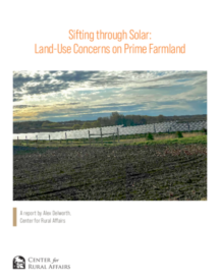The U.S. is in the beginning stages of a major expansion in the solar energy industry. The Department of Energy’s Solar Futures study estimates that to fully decarbonize the energy grid, solar will need to make up 40% to 45% of the energy mix, or about 1,600 gigawatts (GW), of capacity by 2050. That is almost 22 times the current capacity of 73.5 GW, with a majority of that development focused on the coasts. That type of expansion will require an estimated 10.3 million acres of land, 90% of which will be in rural areas. Much of the rural landscape is made up of farmland, especially in the Midwest, and some agricultural stakeholders have raised concerns about solar-related land use.
Solar is a boon to rural economic development. Energy projects bring in new tax revenue for local entities, which is determined by either the rated capacity, annual production, or a mixture of both, depending on the state. Counties can then use the money for special public works projects, to increase funding to schools and other essential services, or to decrease property tax levies.
Renewable energy projects also contribute economic benefits directly to community members. In 2022, owners of clean energy projects in Iowa delivered $73.4 million in lease payments to landowners, which provides stable, diversified income to farmers. Solar projects can bring temporary and permanent rural employment opportunities. In 2022, clean energy counted for 147,000 jobs in rural areas and grew by almost 4%.
With the growing development of renewables in rural areas, concerns over the protection of agricultural lands have targeted utility-scale solar energy systems. Solar projects like these can often take up significant land—hundreds, or even thousands, of acres. Utility-scale solar offers many benefits to the electric utility grid by helping meet peak demand periods and improving the ability to persevere through extreme weather conditions, increasing grid reliability. Wind and solar sources were also more than 36% cheaper than coal in 2020.


